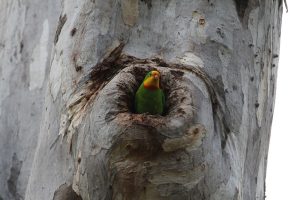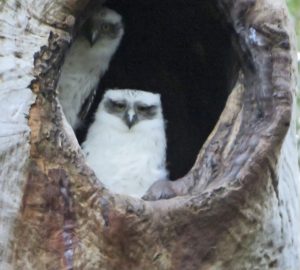
On the 16th March 2022 Dr Beth Mott, Threatened Species Officer, NSW Department of Planning and Environment (Wollongong) gave a talk to Sutherland group. Beth presented us her research and passion for studying tree hollows and the fauna that use them. Beth has worked on Powerful Owl projects as well as other threatened species studies.
Beth began by impressing on us the importance of preserving plant life, especially old trees, which have many physical, social and landscape values. They provide shade, carbon sequestration, habitat values and noise reduction. They all provide mental health benefits and happiness for us humans.
A total of 25 of 70 priority threatened species occur in urban spaces and, therefore, trees, especially old trees, become vitally important in the urban landscape. Old trees provide essential hollows for animals, they sequester large amounts of carbon, and they produce large amounts of nectar and flower resource for a wide variety of fauna. It has been noted that old trees will continue to increase their flower and nectar production.
A total of 176 species of fauna in south-east Australia will use trees. Amazingly, some animals will use a tree hollow as a source of isolation, a hospital room if you like, to get rid of diseases such as “beak and feather” (birds) and chytrid fungus which affects frogs. Many tree hollows occur at the urban-bushland interface.
Fauna can use multiple tree hollows to get through their lifecycle. Hollows in alive trees will likely have different insulating properties compared to dead-tree hollows.
Hollows form in trees usually by 3 dependable steps. The first step involves physical damage, usually by a storm, wind, or fire. Bacteria and fungus as well as insects will then infect the damaged area (where a branch may have snapped) and stop the tree completely healing that area (step 2). Larger fauna may then start to use the cavity or hollow which tends to keep it stable and open (step 3). Small hollows can take 100 years to form. Medium to large hollows can take over 200+ years. So, they are not really a renewable resource according to our timelines of progress. Usually, areas that were spared from logging, have more hollow-bearing trees.
Most species of gums and boxes tend to produce more and better hollows, compared to stringybarks and ashes. Good eucalypt species are Eucalyptus camaldulensis (River Red Gum), Angophora costata (Sydney Red Gum), E. viminalis (Manna Gum), E. cypellocarpa (Mountain Grey Gum), E. mellidora (Yellow Box), as well as other species such as Lophostemon confertus (Brush Box) and Nothofagus moorei (Antarctic Beech). Introduced tree species are not really reliable as hollow-bearing trees, regardless of how long ago they were planted.
Fauna interact with the hollow with signs always left behind, within the hollow, after use. One material left is “mud-guts” – a friable material which seems to be a mixture of fine woody material and animal manure. This may provide a unique recycling habitat and resource for ecosystems, and it can be hard to replicate this artificially.
Senior Scientists have warned and advised that hollow-bearing trees need to be retained and replaced as much as possible, and the current rate of loss is simply too much.
Forested areas can have 7 to 27 hollow-bearing trees per hectare.Many hollow-bearing trees are removed in urban areas due to fears about tree safety in terms of stability. It is also argued that hollow-bearing trees are more of a fire risk, where they tend to burn from the inside-out when embers enter.
More emphasis is needed by law enforcement to conserve hollow-bearing trees, otherwise it is predicted that they will be lost from urban environments by 2100.
Some arboriculture work does take place where trees are lopped to make them safe as a hollow-bearing resource.

When tree hollows become rare, competition between fauna species can become intense. Beth has observed Sulphur-Crested Cockatoos removing Powerful Owl chicks from hollows. In one case, Kookaburras were using a hollow beneath a larger hollow being by Powerful Owls. In this case, the entire process seemed to be amicable. However, more and more incidents of attacks between species are being documented, likely due to hollows becoming rarer. Powerful Owl chicks can be attacked viciously by Magpies and Currawongs.
Research has included taking a 3-D image of a tree hollow and replicating it as an artificial hollow and installing it in a tree. So far, this has not proven successful as an attractive alternative.
Drones are now also being used to better monitor activity and conditions within hollows, with data logged. The drone is used when climbing the tree is too dangerous. Research has shown that a natural hollow with bark can maintain an 85% humidity level. Hollows in dead trees tend to be more humid. Temperature is also buffered in live trees. This has implications when climate change is considered.
Beth is not a fan of artificial nest boxes as threatened and other bird species tend not to use them. They are usually used by species already thriving in the urban environment. However, Beth is running experiments where nest boxes are installed, so comparisons can be made with natural hollows.
Nest boxes fluctuate a lot more in terms of temperature and humidity which can mean serious detriment to any animal that chooses to use them.
Beth advocates that stronger legislation is needed to better protect hollow bearing trees. More education is needed as well as more research to better report on how fauna is directly impacted from hollow loss. If you do like to install the odd possum or nesting box (as I do) just consider where you put it and how it is insulated, as it may get too hot for the fauna inside. And let’s advocate for the protection of hollow-bearing trees in our gardens, streets and parks.
You can view a recording of the talk here.
